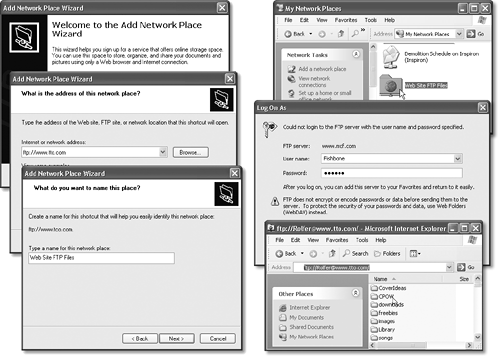20.3 Shared Folders Online
| One of Windows XP's slickest features is its ability to treat hard drives out on the Internet as though they were directly connected to your system. You can create shortcuts that bring servers like these directly onto your screen, where they appear in standard folder windows :
The trick to bringing these servers online is the "Add a network place" link, which you'll find in the task pane at the left side of the My Network Places window. NOTE There's actually a quicker, simpler way to immortalize a server as a shortcut on your desktop: just drag its icon out of the Address bar of Internet Explorer or an open folder, as shown in Figure 20-5. Figure 20-5. If you've already connected to some network server ”whether on your network or on the Internet ”here's a very quick way to create a shortcut of it on your desktop for faster access next time. Just drag the tiny folder icon out of the Address bar. (You can put it on your desktop or, if it feels more consistent to do so, into your My Network Places folder.) 20.3.1 Bringing an FTP or Web Server OnlineTo view the contents of an FTP server or an offline backup service, start by clicking the "Add a network place" link. When the wizard appears (see Figure 20-6), click Next. Wait, if necessary, while your PC goes online. Then, on the second screen, click "Choose another network location." Click Next. Figure 20-6. Left: The Add Network Place Wizard (top) walks you through setting up a desktop icon for your Web, FTP, or intranet site, including (middle) entering the location of the folder or file for which you want to create a shortcut in your My Network Places window ”in this case, an FTP server (bottom). Right: When you double-click the newly created FTP icon (top), you'll be asked for your password (middle). Thereafter, depending on the speed of your connection, the files in the FTP folder might show up on your screen as though they were sitting on a very, very slow floppy disk (bottom). NOTE You can also use this wizard to sign up for one of the above mentioned Web-based "offline disk" services. The second wizard screen lists, for example, the MSN Communities service ("Share your files with others, or store them for your personal use"). In theory, Microsoft may add other, similar services to this screen. Finally you arrive at the critical screen, where you can type in the address of the Web site, FTP site, or other network location that you want your new shortcut to open. Into the first text box, you can type any of these network addresses:
What happens when you click Next depends on the kind of address you specified. If it was an FTP site, you're offered the chance to specify your user name. (Access to every FTP site requires a user name and password. You won't be asked for the password until you actually try to open the newly created folder shortcut.) Click Finish to complete the creation of your network shortcut, which now appears in the My Network Places window. To save you a step, the wizard also offers to connect to and open the corresponding folder. The beauty of all this is that these remote folders appear in everyday, ordinary folder windows (or in Internet Explorer), as shown at bottom right in Figure 20-6. You can work with them exactly as though they were sitting on your own hard drive. The only difference is that because you're actually communicating with a hard drive via the Internet, the slower speed may make it feel as if your PC has been drugged. |
EAN: 2147483647
Pages: 230